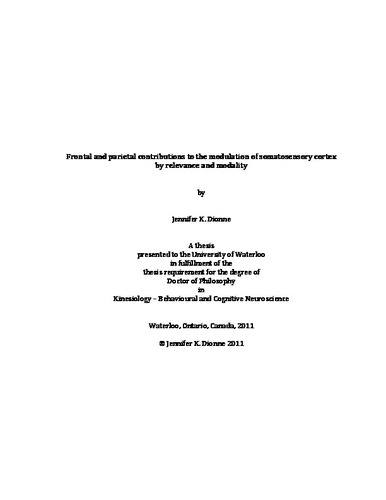| dc.contributor.author | Dionne, Jennifer Kathleen | |
| dc.date.accessioned | 2011-01-21 19:03:06 (GMT) | |
| dc.date.available | 2011-01-21 19:03:06 (GMT) | |
| dc.date.issued | 2011-01-21T19:03:06Z | |
| dc.date.submitted | 2011 | |
| dc.identifier.uri | http://hdl.handle.net/10012/5755 | |
| dc.description.abstract | Afferent somatosensory inputs ascend from the periphery to the cortex carrying information about touch that is critical for planning motor responses. At the cortical level, this information is subject to modulation from its earliest arrival in somatosensory cortex where factors such as task-relevance begin to shape how the sensory signals are processed. The goal of such modulation is largely to facilitate the extraction of relevant sensory information (and suppression of irrelevant signals) early in the processing stream, and these functions are in part carried out by top-down influences from cortical and sub-cortical structures. Efforts to understand the mechanisms contributing to modulation of sensory-specific cortex have revealed that crossmodal signals (i.e. simultaneously presented stimuli from a different modality) can also influence early sensory processing, but the precise nature of this modulation and what may drive it is largely unknown. It is the purpose of this thesis to investigate the modulation of somatosensory cortex, specifically how task-relevant modulation of somatosensory cortex might be influenced by crossmodal (visual) stimuli, and whether specific task requirements have any bearing on SI excitability. The studies comprising this thesis aim to address these gaps in our mechanistic understanding of the networks involved in modulating somatosensory cortex. Studies 1 and 2 employed functional magnetic resonance imaging (fMRI) and electroencephalography (EEG) to investigate how task-relevant visual and vibrotactile stimuli modulate somatosensory cortex and to probe the role of a frontoparietal network in mediating this modulation. Studies 3 and 4 also used EEG to determine how manipulating the relevance of the stimuli affects the modulation of somatosensory event-related potentials (ERPs), and to probe how task-specific sensory-motor requirements mediate excitability in somatosensory cortex as well as frontal and parietal regions. The results of this thesis provide insight into the factors that modulate somatosensory cortex and the role of a fronto-parietal network in subserving these modulations. | en |
| dc.language.iso | en | en |
| dc.publisher | University of Waterloo | en |
| dc.subject | behavioural neuroscience | en |
| dc.subject | sensorimotor control | en |
| dc.title | Frontal and parietal contributions to the modulation of somatosensory cortex by relevance and modality | en |
| dc.type | Doctoral Thesis | en |
| dc.pending | false | en |
| dc.subject.program | Kinesiology (Behavioural Neuroscience) | en |
| uws-etd.degree.department | Kinesiology | en |
| uws-etd.degree | Doctor of Philosophy | en |
| uws.typeOfResource | Text | en |
| uws.peerReviewStatus | Unreviewed | en |
| uws.scholarLevel | Graduate | en |

